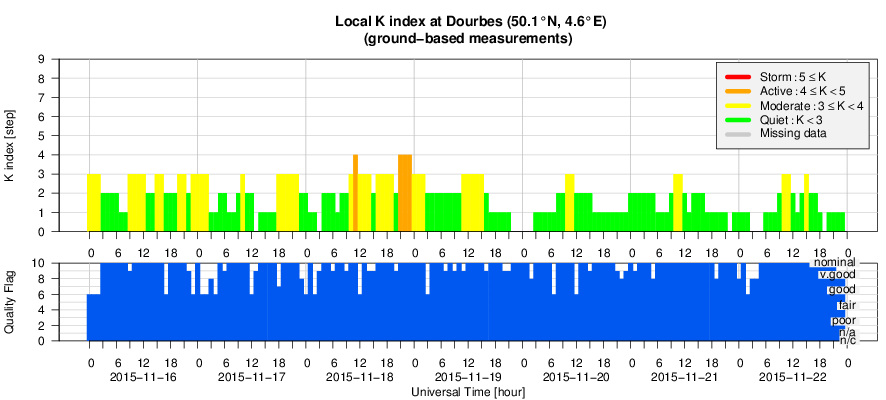- Table of Content
- 1.ESWW12 in full...
- 2.PROBA2 Observa...
- 3.Review of sola...
- 4.The Internatio...
- 5.Geomagnetic Ob...
- 6.Review of iono...
- 7.Future Events
2. PROBA2 Observations (16 Nov 2015 - 22 Nov 2015)
3. Review of solar and geomagnetic activity
4. The International Sunspot Number
5. Geomagnetic Observations at Dourbes (16 Nov 2015 - 22 Nov 2015)
6. Review of ionospheric activity (16 Nov 2015 - 22 Nov 2015)
7. Future Events
ESWW12 in full swing!
It's Wednesday, 25 November, we're halfway the twelfth European Space Weather Week (ESWW), and everything is working out fine. Underneath a few images that give an idea on what has been going on so far.
ESWW12 obviously started not so well in view of the high threat level in Brussels. However, Oostende is a quiet town at the Belgian coast and everybody made it safely to the conference location. Underneath image portrays the arrival of some participants under the alert eyes of two police men.
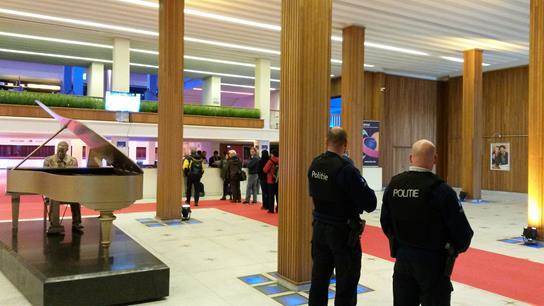
The venue of the ESWW12 was the Casino Kursaal in Oostende. Underneath a view on the "Erehal", where most of the side activities took place and where there was plenty of space for informal discussions.
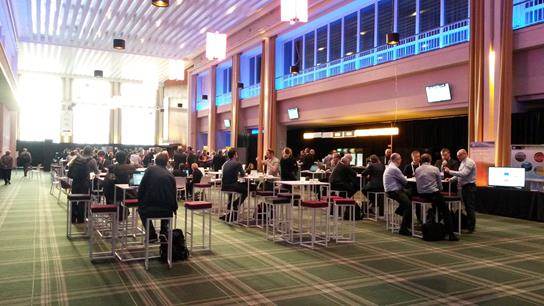
Keeping up a good tradition, the ESWW started again with a Tutorial. This year, the main theme was "space exploration", with a brief introduction by Eamonn Daly, and a "Meet and Greet" (4 groups of participants visiting consecutively 4 local presenters for a short talk). Then followed a debate moderated by Dave Pitchford on the space weather challenges for space exploration, and the Tutorial ended with the inevitable quiz. The first day concluded with a medal ceremony and a Welcome reception in the nearby Thermae Palace.

Every day started with keynote lectures followed by sessions (16 for the whole week) and working meetings (17 in total!) in the afternoon. These were very well attended by the participants, as is testified by the picture underneath. Though there were a few conveners who could not make it to the ESWW, most of them managed to delegate their presentation or working meeting to a representative.
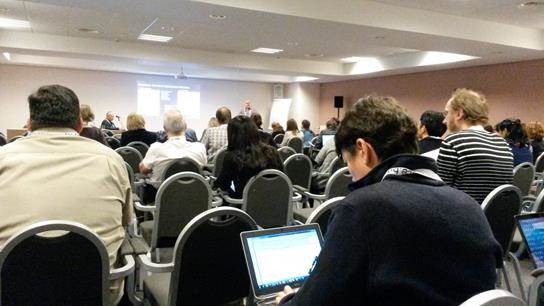
From Tuesday till Friday, there was also a live space weather forecast presented by resp. SIDC, BGS, SWPC and MOSWOC (see http://www.stce.be/esww12/liveforecast.php for program and abbreviations). The presentation was filmed and replayed for the rest of the day.
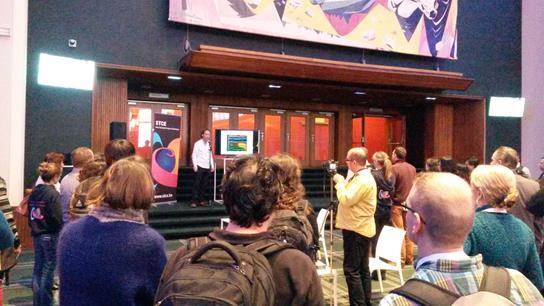
On Wednesday, there was also a Fair, where users and service providers had the opportunity to get acquainted and learn about space weather, the mutual needs, the available tools, applications, services, and so much more. It is a very well attended event, not only because it is followed by the traditional beer tasting. Some of the stands were permanent, i.e. accessible throughout the entire week.
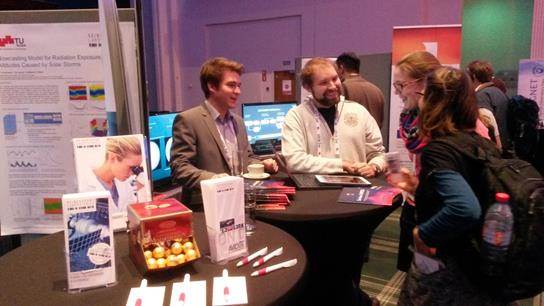
With still a lot of interesting sessions and the conference dinner to come, this ESWW is shaping up to become a very rewarding edition.
PROBA2 Observations (16 Nov 2015 - 22 Nov 2015)
Solar Activity
Solar flare activity fluctuated between very low and low during the week.
In order to view the activity of this week in more detail, we suggest to go to the following website from which all the daily (normal and difference) movies can be accessed:
http://proba2.oma.be/ssa
This page also lists the recorded flaring events.
A weekly overview movie can be found here (SWAP week 295).
http://proba2.oma.be/swap/data/mpg/movies/weekly_movies/weekly_movie_2015_11_16.mp4
Details about some of this week’s events, can be found further below.
Monday Nov 16
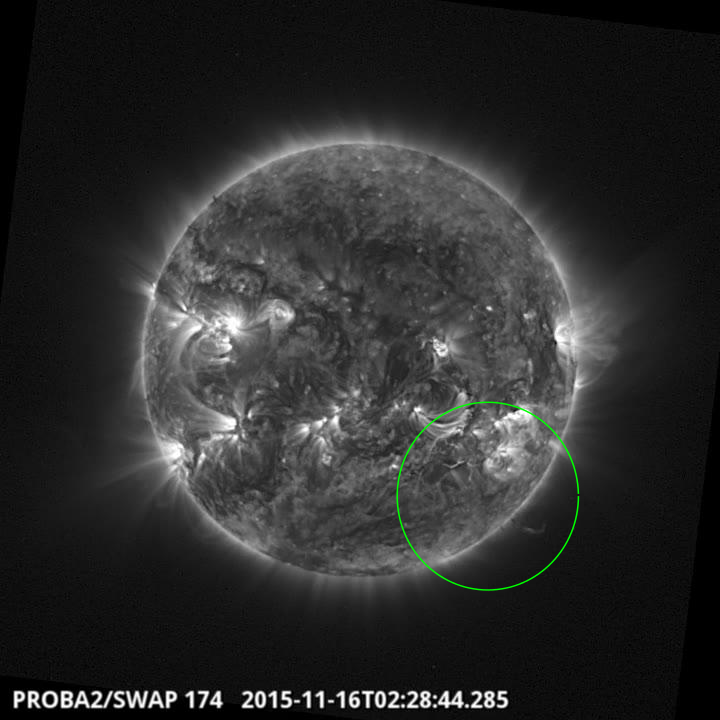
Filament eruption on the south west quadrant @ 02:25 UT SWAP image
Find a movie of the events here (SWAP movie)
http://proba2.oma.be/swap/data/mpg/movies/20151116_swap_movie.mp4
Wednesday Nov 18
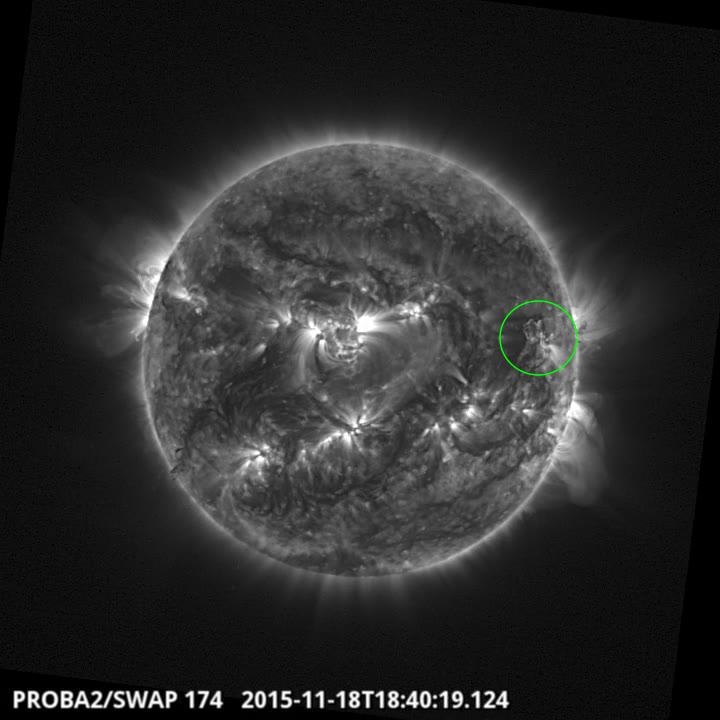
Eruption on the north west quadrant @ 18:40 UT SWAP image
Find a movie of the event here (SWAP movie)
http://proba2.oma.be/swap/data/mpg/movies/20151118_swap_movie.mp4
Sunday Nov 22
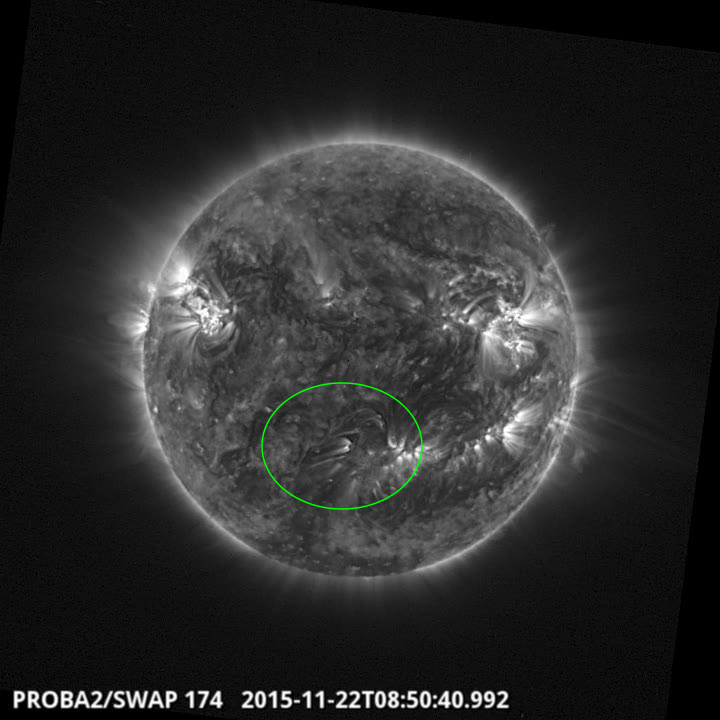
Eruption near disk centre @ 08:50 UT SWAP image
Find a movie of the event here (SWAP movie)
http://proba2.oma.be/swap/data/mpg/movies/20151122_swap_movie.mp4
Review of solar and geomagnetic activity
SOLAR ACTIVITY
Solar activity was low at the start of the week with just a couple of isolated C flares from NOAA region 2454 and a new region 2457 rotating onto the disk from the East. Towards the end of the week new flux emergence was observed in region 2454 which then produced several C flares. The largest flare of the period was a C5.6 flare peaking at 5:38 UT November 22 from NOAA region 2454.
No Earth directed CME's left the Sun during the period. A large filament stretching over the SouthEastern quadrant started lifting of around 7:00 UT November 22 but its associated CME was directed East off the Sun-Earth line and no impact at Earth is expected.
GEOMAGNETIC ACTIVITY
Solar wind conditions were near to nominal at the start of the week and further decreasing. Around 19:40UT November 17 the magnetic field phi angle turned from the positive into a negative (towards) sector and solar wind started to rise around noon November 18 under the expected influence of a negative polarity coronal hole. The expected arrival of a shock related to the November 16 CME was observed at 19:23 UT November 18 with magnetic field increasing suddenly from 6 to 12.7nT and with associated minor jumps in solar wind speed (420 to 450 km/s) and density. The Bz field became pronounced negative for a while after the shock. Solar wind speed attained peaks of around 500km/s but was quickly followed by a decaying trend reaching nominal conditions by late November 19.
Locally active geomagnetic conditions (K Dourbes 4) were reported associated to the CME shock arrival with minor geomagnetic storms at planetary level (NOAA Kp 5). Otherwise the geomagnetic conditions were quiet to unsettled throughout the week.
The International Sunspot Number
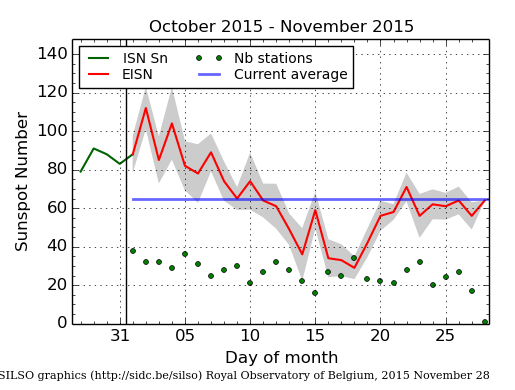
The daily Estimated International Sunspot Number (EISN, red curve with shaded error) derived by a simplified method from real-time data from the worldwide SILSO network. It extends the official Sunspot Number from the full processing of the preceding month (green line). The plot shows the last 30 days (~ one solar rotation). The horizontal blue line shows the current monthly average, while the green dots give the number of stations included in the calculation of the EISN for each day.
Review of ionospheric activity (16 Nov 2015 - 22 Nov 2015)
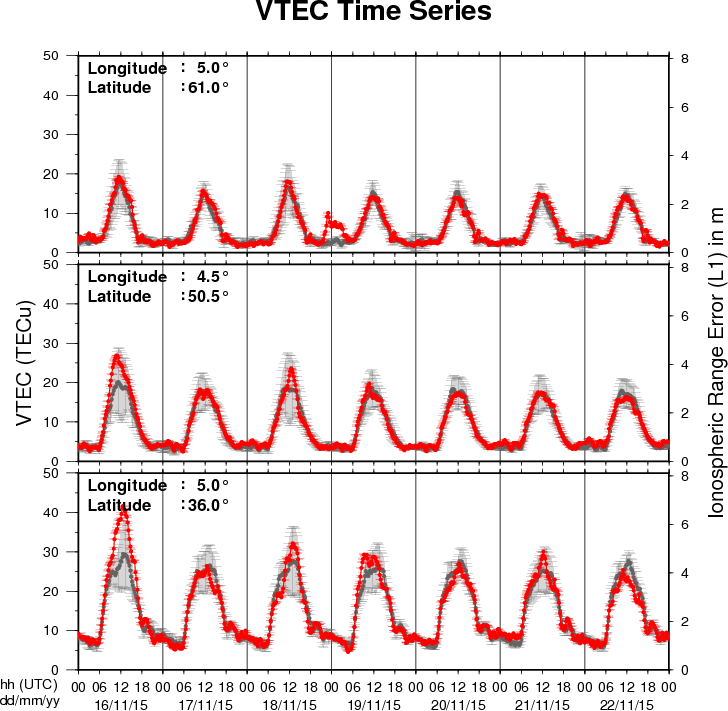
The figure shows the time evolution of the Vertical Total Electron Content (VTEC) (in red) during the last week at three locations:
a) in the northern part of Europe(N61°, 5°E)
b) above Brussels(N50.5°, 4.5°E)
c) in the southern part of Europe(N36°, 5°E)
This figure also shows (in grey) the normal ionospheric behaviour expected based on the median VTEC from the 15 previous days.
The VTEC is expressed in TECu (with TECu=10^16 electrons per square meter) and is directly related to the signal propagation delay due to the ionosphere (in figure: delay on GPS L1 frequency).
The Sun's radiation ionizes the Earth's upper atmosphere, the ionosphere, located from about 60km to 1000km above the Earth's surface.The ionization process in the ionosphere produces ions and free electrons. These electrons perturb the propagation of the GNSS (Global Navigation Satellite System) signals by inducing a so-called ionospheric delay.
See http://stce.be/newsletter/GNSS_final.pdf for some more explanations ; for detailed information, see http://gnss.be/ionosphere_tutorial.php
Future Events
For more details, see http://www.spaceweather.eu/en/event/future
COSPAR/ILWS workshop: science for space weather in Goa, India
Start : 2016-01-24 - End : 2016-01-29
Understanding and being able to forecast space weather is an
increasingly important aspect of our modern technology-reliant
society. This workshop will treat all aspects of space weather,
ranging from solar origins of transient events (CMEs, Flares, CIRs)
to their propagation through the heliosphere and effects on Earth
and planetary bodies, from particle energization to forecasting
particle environment and its effects on technological and
biological systems, as well as solar-cycle effects and coupling of
space weather to atmospheric response. Metrics to assess
predictions will also be discussed. The workshop is structured
along the lines of the COSPAR space weather pathways and will
include invited, contributed talks and posters, as well as panel
discussions and tutorials.
Website:
http://www.cessi.in/ssw/program.html
The Scientific Foundation of Space Weather
Start : 2016-06-27 - End : 2016-07-01
Website:
http://www.issibern.ch/program/workshops.html
